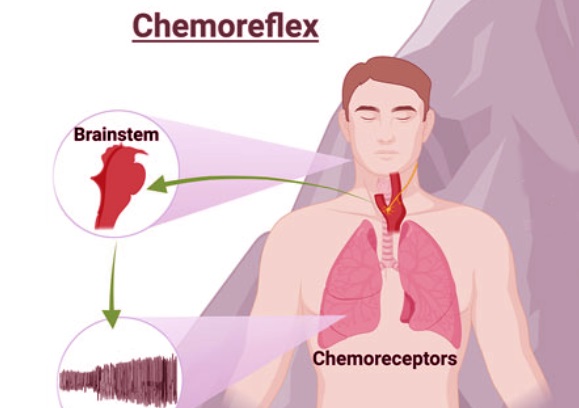Nikhil Prasad Fact checked by:Thailand Medical News Team Aug 07, 2025 5 months, 1 hour, 19 minutes ago
Medical News: Understanding the Chemoreflex System
A new review by researchers from the Department of Cellular and Integrative Physiology and the Department of Anesthesiology at the University of Nebraska Medical Center in Omaha, USA, explores how a little-known body system called the chemoreflex could explain the severe symptoms seen in many COVID-19 patients.
 Chemoreflex Dysfunction Could Be Key to COVID-19 Severity
Chemoreflex Dysfunction Could Be Key to COVID-19 Severity
The chemoreflex is the body’s built-in alarm system that detects abnormal oxygen or carbon dioxide levels in the blood. It does this through tiny sensors located in the neck known as the carotid bodies, which work alongside other sensors in the brainstem. When oxygen levels drop or carbon dioxide levels rise, the chemoreflex kicks in to adjust breathing and restore balance.
This
Medical News report reveals that COVID-19 may damage or impair these sensors, affecting how patients respond to low oxygen levels. In some cases, this could lead to what’s called “silent hypoxia”—a dangerous condition where oxygen levels fall dangerously low without triggering breathlessness.
COVID-19 and the Chemoreflex Connection
The study explains that during COVID-19 infection, either direct viral attack or inflammation may disrupt chemoreflex function. Autopsy findings even show the presence of the virus in the carotid body’s glomus cells. These cells are responsible for detecting oxygen changes in the blood.
What makes this especially concerning is that people with pre-existing conditions like diabetes, obesity, or heart problems—which already stress the chemoreflex system—may experience even more severe COVID-19 symptoms. In such patients, the chemoreflex may become overly active, leading to harmful effects on breathing, the nervous system, and even the heart and kidneys.
In contrast, some individuals may have a completely blunted chemoreflex response. This could explain why some COVID-19 patients have dangerously low oxygen levels yet feel no shortness of breath until it’s too late. These findings show how COVID-19 isn’t just a lung disease but one that hijacks essential body systems involved in basic survival responses.
Why This Matters in Treating COVID-19
The chemoreflex is more than just a sensor for oxygen levels—it also interacts with the immune system. In COVID-19, inflammatory molecules like IL-6 and TNF-alpha may increase chemoreflex activity, sending the body into a spiral of inflammation and overreaction. This could worsen breathing problems and explain why some patients deteriorate quickly.
Researchers suggest that by better understanding the chemoreflex’s role in COVID-19, doctors might one day be able to predict who is most at risk for severe disease and tailor treatments accordingly. For example, drugs that calm the overactive chemoreflex might help patients who are suffering from breathing instability or erratic blood pressure due to the virus.
/>
An Overlooked System Deserves More Attention
Although chemoreflex dysfunction has been studied in other diseases like sleep apnea and chronic lung disorders, its role in COVID-19 is only now coming to light. The researchers urge further studies to explore how this system might explain the mystery behind “silent hypoxia” and other unusual COVID-19 symptoms.
They also point out that future therapies might aim to “reset” or calm the chemoreflex in vulnerable patients, especially those with long-term complications. Until now, the chemoreflex hasn’t been part of mainstream COVID-19 research, but this review suggests that could be a major oversight.
The study findings were published in the peer reviewed journal: The Journal of Physiology
https://physoc.onlinelibrary.wiley.com/doi/10.1113/JP286655
For the latest news, keep on logging to Thailand
Medical News.
Read Also:
https://www.thailandmedical.news/news/gut-microbiome-imbalance-drives-covid-19-severity-and-complicates-recovery
https://www.thailandmedical.news/news/new-study-find-that-il-1-beta-as-a-key-driver-of-covid-19-severity-and-not-inflammasome-activation-and-pyroptosis
https://www.thailandmedical.news/news/gastroesophageal-reflux-disease-gerd-increases-risks-of-covid-19-severity
